Minnesota is known for cold winters but the state has a lot more to offer than snow. One thing is consistent with the state’s lakes and that’s excellent fishing. Nearly every single lake in Minnesota offers an extremely wide range of fish species.
From the state’s largest, Lake of the Woods, to the much smaller Cass Lake, each has its own charm and unique characteristics. Fish species tend to vary across the lakes in Minnesota with walleye being the main species targeted by anglers. Lake of the Woods is even known as The Walleye Capital of the World.
Minnesota is also home to Lake Pepin where water skiing was invented! Mille Lacs Lake is a great fishery and also provides outstanding birdwatching opportunities. Minnesota is home to an array of lakes in many shapes, depths, forms, and sizes providing plenty of outdoor recreational opportunities for tourists and locals alike; just remember your coat.
Let’s dive into 10 of the best lakes in Minnesota!
1. Red Lake
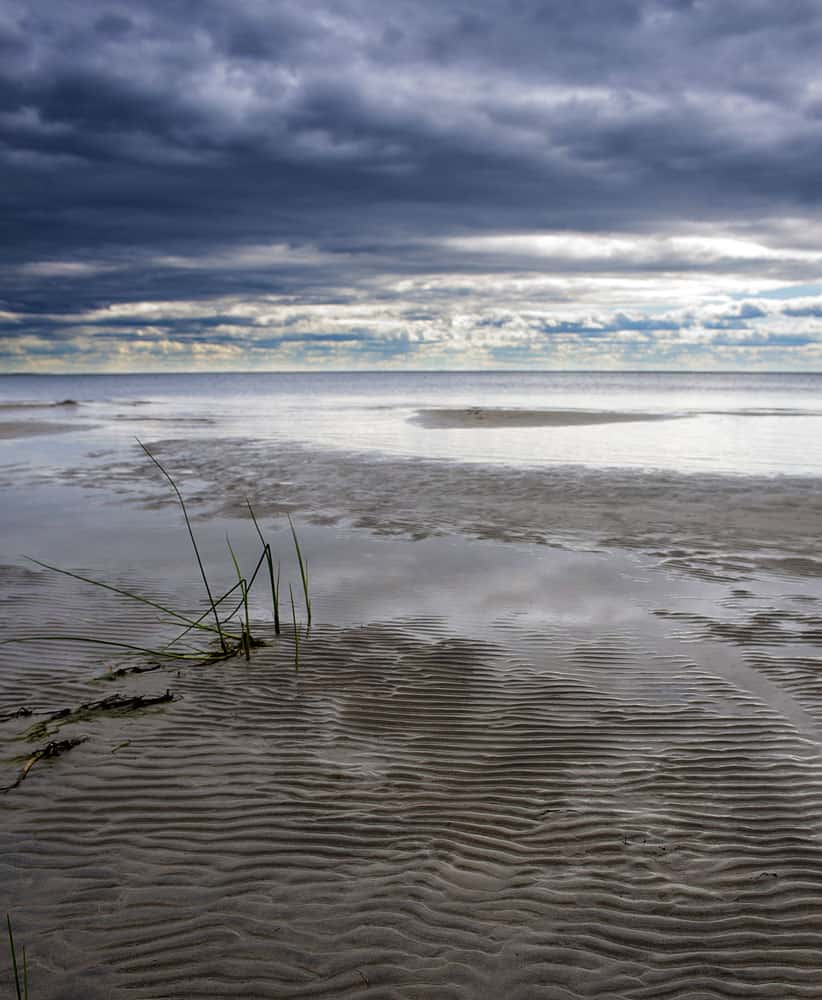
Red Lake is the largest natural freshwater lake located entirely within the state of Minnesota and home to trophy northern pike.
©iStock.com/kent johnson
● Surface Area: 288,800 Acres
● Max Depth: 273 Feet
● Camping/Overnight Available: Yes
● Boating/Docks Available: Yes
● Swimming Permitted: Yes
● Fishing Permitted: Yes
● Best For: Wide Range of Fish Species, Largest Freshwater Lake In Minnesota, Sixteenth Largest Lake In the United States, Red Water, Trophy Northern Pike, Dense Walleye Population, Great Ice Fishing
Red Lake is located in the northern part of Minnesota and is the largest natural freshwater lake in the state. Red lake is the sixteenth largest lake in the United States and it lies entirely within the Red Lake Indian Reservation. The water of the lake is red in color and the name is derived from the Ojibwe word Miskwaagamiiwi-zaaga’igan.
Abundant walleye and trophy northern pike are two of the primary fish species targeted at Red Lake. Two other popular catches at Red Lake are slab crappie and jumbo perch. The lake also hosts a very wide selection of other fish species including black & brown bullhead, black crappie, bluegill, burbot, freshwater drum, golden redhorse, lake trout, lake whitefish, lake sturgeon, largemouth bass, muskie, quillback, rock bass, shorthead redhorse, white sucker, goldeye, and bigmouth buffalo.
Red Lake’s shape essentially splits the body of water into two separate and distinct areas. One area is referred to as Upper Red Lake and the other is Lower Red Lake; each has slight differences that make it unique. It’s extremely important to note that roughly sixty percent of Upper Red Lake is not open to the public and requires a tribal guide for access.
2. Rainy Lake
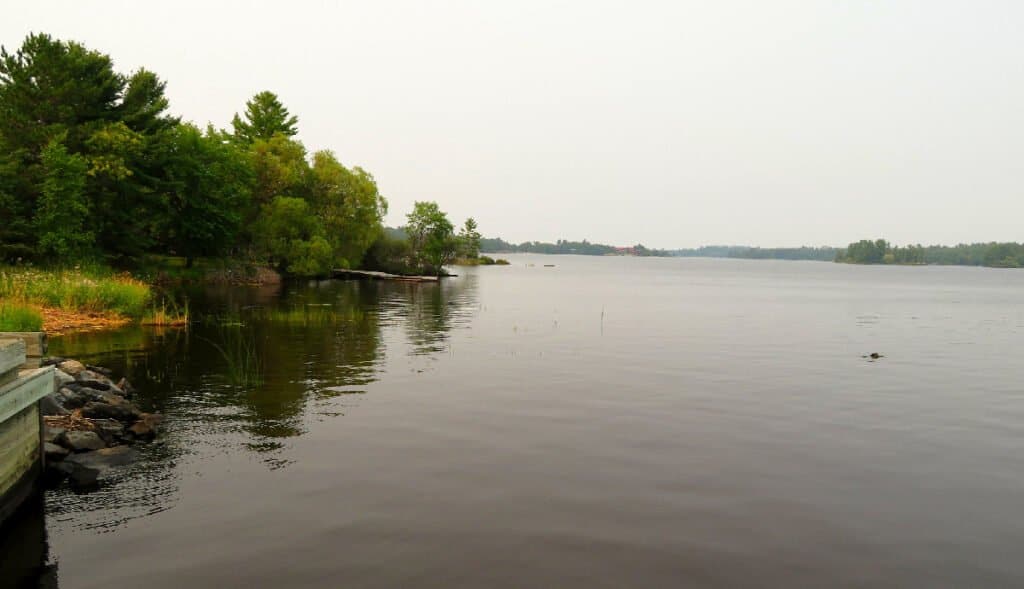
Rainy Lake is a top Michigan walleye fishing spot and a water sports lover’s paradise.
©Ken Lund / flickr – License
● Surface Area: 230,400 Acres
● Max Depth: 160 Feet
● Camping/Overnight Available: Yes
● Boating/Docks Available: Yes
● Swimming Permitted: Yes
● Fishing Permitted: Yes
● Best For: Top
\Walleye Fishing Lake, Diverse Range of Fish Species, Water Sports Lover’s Paradise
Located in the northeastern area of Minnesota near International Falls and Ranier, Rainy Lake is well known for its killer walleye fishing. The lake’s waters span from Minnesota into Canada forming a part of the international border. Popular activities at Rainy Lake include boating, kayaking, swimming, canoeing, sailing, snowshoeing, and cross-country skiing.
Rainy Lake is a world-class walleye fishing destination for locals and tourists. In addition to walleye, Rainy Lake offers a diverse fish species population. Some of the fish species targeted by anglers at Rainy Lake include smallmouth bass, crappie, northern pike, muskellunge, and sturgeon.
Ice-fishing and snowmobiling are two extremely popular activities at Rainy Lake and in the winter months, hundreds of ice-fishing shelters can be spotted. Ice-fishing derbies are common and heavy hauls of fish are usually taken. Visitors should be aware that Canadian laws apply to portions of the lake where it stretches into Canada.
3. Mille Lacs Lake
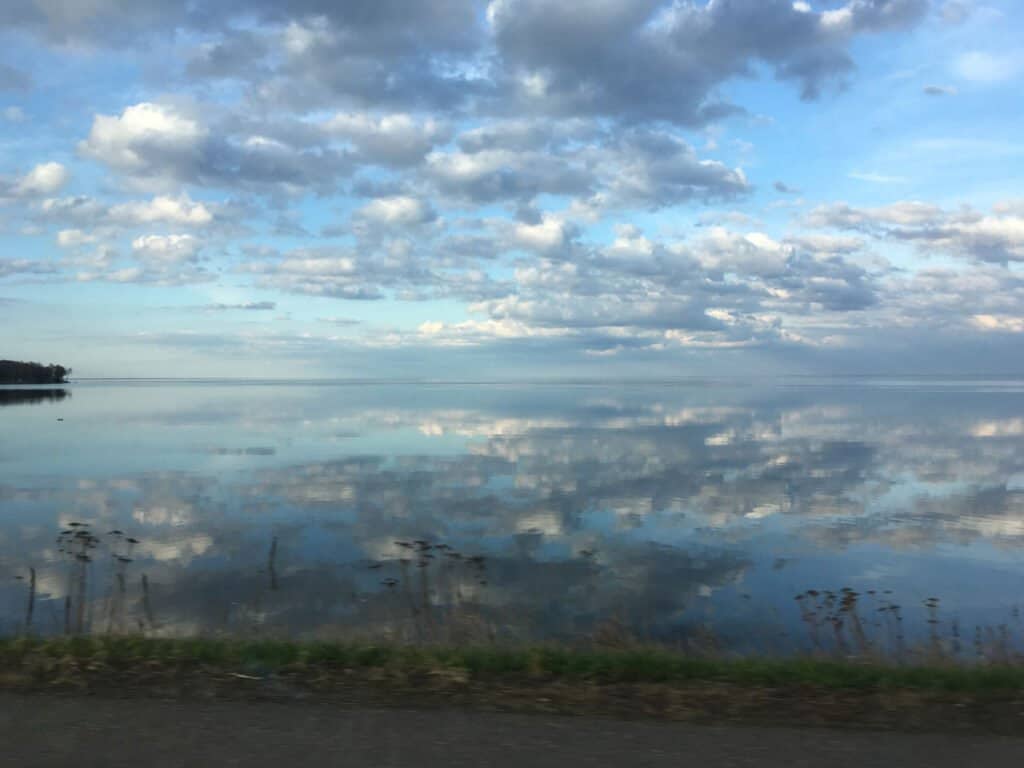
Mille Lacs Lake is located about seventy-five miles north of Minneapolis and is known for trophy northern pike and walleye fishing.
©iStock.com/jamiep651
● Surface Area: 132,500 Acres
● Max Depth: 42 Feet
● Camping/Overnight Available: Yes
● Boating/Docks Available: Yes
● Swimming Permitted: Yes
● Fishing Permitted: Yes
● Best For: Trophy Northern Pike and Walleye Fishing, Diverse & Abundant Fish Population, Bassmaster’s 2015 “100 Best Bass Lakes”, Birdwatching
The lake’s name Mille Lacs translates from French to thousand lakes. Mille Lacs Lake is located in the central-western area of Minnesota and about seventy-five miles north of Minneapolis. The primary water source flowing into the lake is Garrison Creek with the main outflow being Rum River. Originally the lake was the central area where various Dakota tribes began to migrate into different parts of the United States; the first Europeans arrived in 1678.
Mille Lacs Lake is a phenomenal destination for anglers with its extremely diverse fish species population. In addition to the wide range of fish at Mille Lacs Lake, the fish are abundant and productive fishing is available all year long. The primary fish species targeted by anglers at Mille Lacs Lake include walleye, northern pike, muskie, jumbo perch, smallmouth bass, largemouth bass, and tullibee.
The fishing is in fact so good at Mille Lacs Lake that it was ranked tenth in Bassmaster’s 2015 “100 Best Bass Lakes.” Beyond the spectacular fishing at Mille Lacs Lake visitors can enjoy horseback riding, hunting, shooting, archery, cross country skiing, Mille Lacs Kathio State Park, the Mille Lacs Lake Museum, biking, hiking, and birdwatching. Lake visitors can view an extremely wide and diverse amount of birds including red-breasted nuthatch, brown creeper, blue-gray gnatcatcher, golden-crowned kinglet, eastern bluebird, gray-cheeked thrush, European starling, house sparrow, yellow-headed blackbird and snow geese to name just a few.
4. Leech Lake

Leech Lake is a top-notch walleye and muskie fishery located in north-central Minnesota.
©iStock.com/Sakkawokkie
● Surface Area: 102,947 Acres
● Max Depth: 156 Feet
● Camping/Overnight Available: Yes
● Boating/Docks Available: Yes
● Swimming Permitted: Yes
● Fishing Permitted: Yes
● Best For: Third Largest Lake In Minnesota, Walleye and Muskie Fishing, Irregular Shape, Chippewa National Forest, State Record Lake Whitefish & Pumpkinseed
Leech Lake, located in the north-central area of Minnesota, is known to provide the best walleye and muskie fishing in the midwest. Leech Lake is seated primarily in the Leech Lake Indian Reservation, and it’s the third-largest lake in the state of Minnesota. Leech Lake has a one hundred and ninety-five-mile shoreline that has a very unusual and irregular shape.
Anglers know Leech Lake to be a productive largemouth bass, northern pike, sunfish, and crappie fishery. Leech Lake offers a wide range of other fish species including dogfish, bluegill, brown bullhead, catfish, eelpout, muskellunge, pumpkinseed, rock bass, smallmouth bass, tullibee, walleye, white sucker, yellow bullhead, yellow perch, and jackfish. Leech Lake is also responsible for producing the state record lake whitefish and pumpkinseed in 1999.
Leech Lake is surrounded by the Chippewa National Forest, a six hundred and sixty-seven-acre forested area with over thirteen hundred lakes! The forest is home to a significant bald eagle population, actually the highest density in the lower forty-eight states with one hundred and fifty nesting pairs. Other wildlife species commonly spotted in Chippewa National Forest at Leech Lake include hawk and woodpecker, red squirrel, weasel, Caspian tern, common loon, common tern, double-crested cormorant, golden-winged warbler, and herring gull.
5. Lake Winnibigoshish
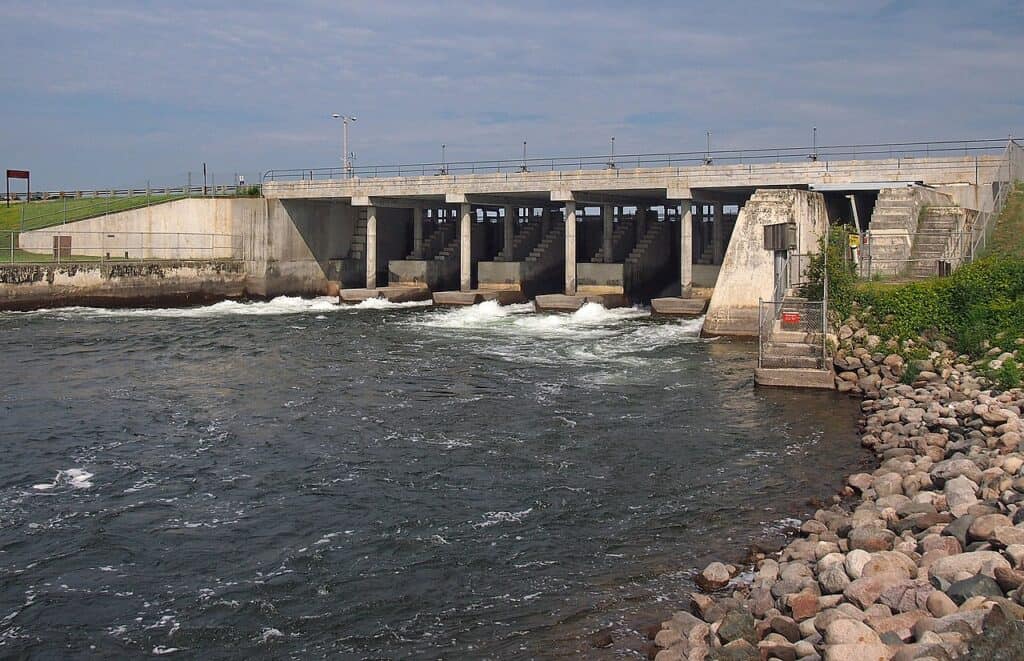
Lake Winnibigoshish, sometimes called Big Winnie, is located in the heart of Minnesota and is known for great walleye, northern pike, perch, and bass fishing.
©McGhiever / Creative Commons – License
● Surface Area: 67,000 Acres
● Max Depth: 70 Feet
● Camping/Overnight Available: Yes
● Boating/Docks Available: Yes
● Swimming Permitted: Yes
● Fishing Permitted: Yes
● Best For: Fourth Largest Lake In Minnesota, Walleye Fishing, Undeveloped Shoreline, Top Minnesota Ice Fishing Lake
Lake Winnibigoshish, also called Big Winnie, is located in north-central Minnesota within the Chippewa National Forest. The lake’s unique name is often misspelled as Lake Winibigosh or Winnibigosh. The name comes from the Ojibwe language and translates loosely to “filthy water” but means “brackish water.”
Residents of Minnesota and beyond know Lake Winnibigoshish to be one of the area’s finest walleye fisheries in the state and the entire region. Other primary fish species targeted by anglers at Lake Winnibigoshish include northern pike and massive-sized perch. In addition to the primary fish species, Lake Winnibigoshish also offers largemouth bass, black crappie, bluegill, hybrid sunfish, pumpkinseed sunfish, rock bass, and muskie.
Lake Winnibigoshish is conveniently located twenty to forty miles from many of northern Minnesota’s major cities. A few of the cities near Lake Winnibigoshish include Bemidji, Cass Lake, Walker, Deer River, and Grand Rapids. In addition to the amazing fishing at Lake Winnibigoshish birdwatching is exceptionally popular with commonly viewed species being red-shouldered hawk, northern goshawk, hermit thrush, mallard, wood duck, and blue-winged teal.
6. Lake Vermilion
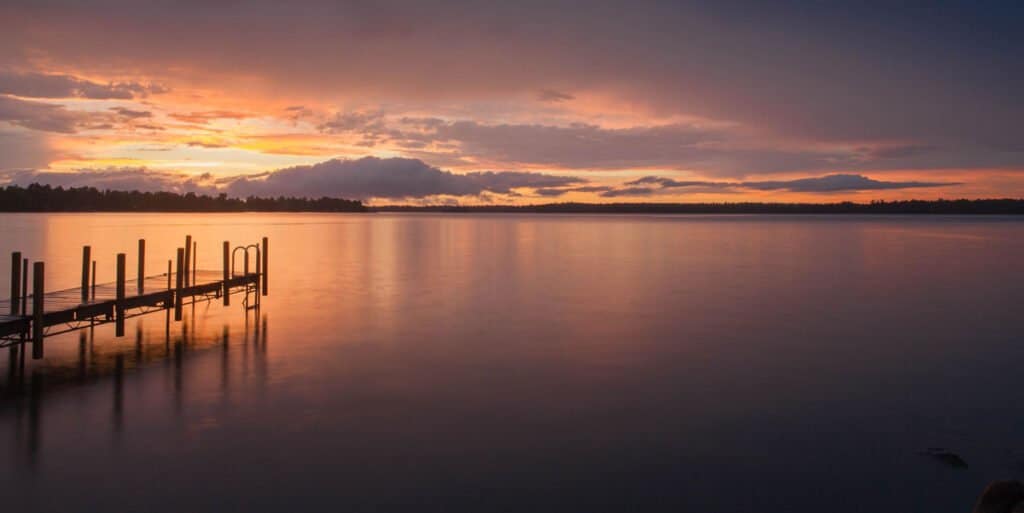
Lake Vermilion is the seventh-largest lake in Minnesota and has the most shoreline out of any other lake in the state.
©iStock.com/5longhausers
● Surface Area: 39,270 Acres
● Max Depth: 76 Feet
● Camping/Overnight Available: Yes
● Boating/Docks Available: Yes
● Swimming Permitted: Yes
● Fishing Permitted: Yes
● Best For: Seventh Largest Lake In Minnesota, Boundary Waters Canoe Area, Largest Shoreline of all Minnesota Lakes, Over Three Hundred Islands
Lake Vermilion gets its name from the Ojibwe word onamuni which means “lake of the sunset glow.” The lake is home to three hundred and sixty-five islands and also has the most shoreline of any lake in Minnesota at three hundred and fourty miles in length. The combination of the lake’s uniquely winding and twisting shoreline and islands present a wide range of fishing opportunities.
Anglers know the lake to be well-stocked and have an abundant amount of fish and a wide range of different fish species. Primary fish species at Lake Vermilion include walleye, muskellunge, northern pike, smallmouth bass, bluegills, crappies, and largemouth bass. Other species common to most northern lakes are also present at Lake Vermilion including yellow perch, lake whitefish, white sucker, and tullibee.
Lake Vermilion is the seventh-largest lake in the state providing sanctuary and home to many different types of wildlife. A few common animals seen in the Lake Vermilion area include timber wolves, black bears, and white-tailed deer. Boundary Waters Canoe Area is accessible on the north side of the lake which was included in The National Geographic Traveler Magazine fifty places around the world!
7. Kabetogama Lake

Kabetogama Lake is One of Minnesota’s Ten Largest Inland Lakes and is well known for its diverse and abundant fish population.
©iStock.com/Kyle Kempf
● Surface Area: 25,700 Acres
● Max Depth: 80 Feet
● Camping/Overnight Available: Yes
● Boating/Docks Available: Yes
● Swimming Permitted: Yes
● Fishing Permitted: Yes
● Best For: Abundant Fish Population, Top Minnesota Vacation Destination, Voyageurs National Park, One of Minnesota’s Ten Largest Inland Lakes, Gold Portage
Located in the far northern region of the state, Kabetogama Lake is one of Minnesota’s ten largest inland lakes. Kabetogama Lake is a close neighbor to Rainy Lake and is separated only by a thin peninsula. The lake boasts an impressive seventy-eight-mile shoreline that provides ample opportunity for the lake’s primary attraction, fishing.
Primary fish species at Kabetogama Lake include walleye, sauger, northern pike, and perch. Other common species targeted by anglers at Kabetogama Lake include smallmouth bass and crappie. In addition to the main species, the lake is well known for having an abundant and diverse fish population including bluegill, burbot, lake sturgeon, lake whitefish, largemouth bass, mooneye, northern pike, rock bass, sauger, shorthead redhorse, silver redhorse, tullibee, and white sucker.
The lake’s enclosing Voyageurs National Park was established in 1975 and spans over two hundred thousand acres. Some of the popular activities at Voyageurs National Park include viewing the Northern Lights, checking out the Gold Portage, and visiting Ellsworth Rock Garden. The Gold Portage offers a great opportunity to view the area’s wildlife, some common species seen include moose, bear, fox, and wolves.
8. Lake Pepin
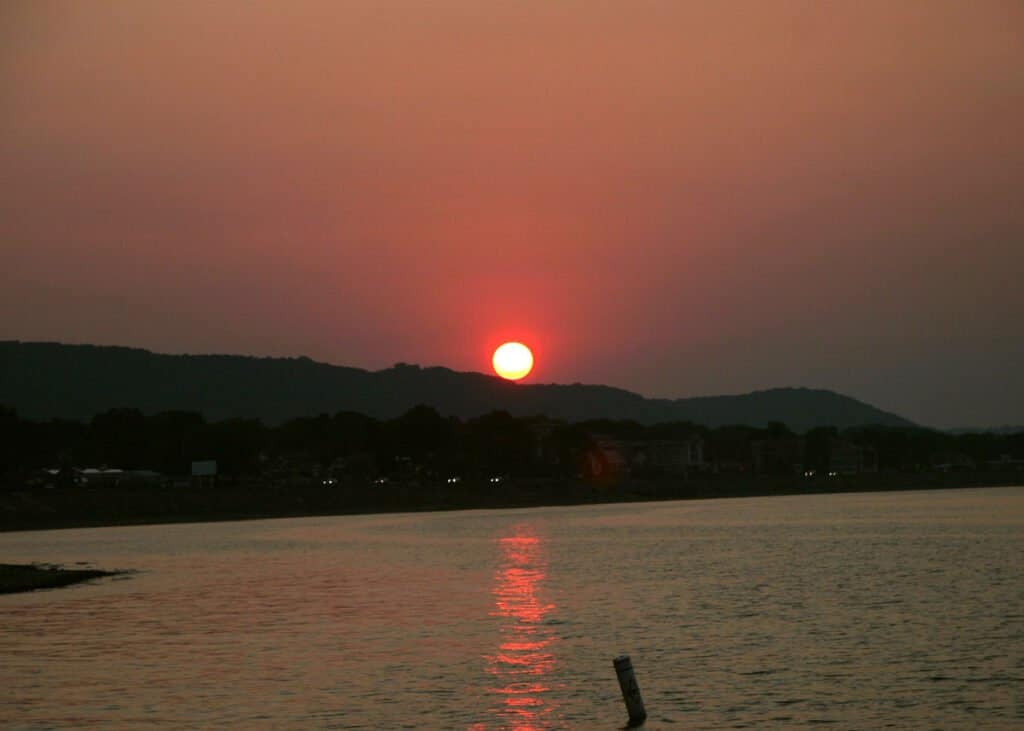
Lake Pepin is located in the central-eastern region of Minnesota and is the actual birthplace of water skiing!
©iStock.com/Jacob Nichols
● Surface Area: 29,295 Acres
● Max Depth: 60 Feet
● Camping/Overnight Available: Yes
● Boating/Docks Available: Yes
● Swimming Permitted: Yes
● Fishing Permitted: Yes
● Best For: Birthplace of Water Skiing, Transportation, Industrial & Commercial Travel, Little House in the Big Woods, Frontenac State Park, Birdwatching
Lake Pepin is a glacially formed lake in the central far eastern part of Minnesota and stretches into Wisconsin. Lake Pepin was named after the French settler Jean Pepin in the year 1703, who made the lake his home. The 1800s brought fur trading to the area and later in the 1900s, the waters were used by the timber industry. It also contains white bass, northern pike, large and smallmouth bass, and sauger.
The lake might be most famously known for being the birthplace of the 1922 invention by Ralph Samuelson known as water skiing. The lake is also the birthplace of Laura Ingalls Wilder and is mentioned in the book Little House in the Big Woods. Lake Pepin is open year-round as opposed to the inland lakes and stands as a great walleye fishery.
Lake Pepin is bordered by the more than two thousand acre Frontenac State Park. The state park is exceptionally well known for birdwatching because of the wide range of species. Some of the birds commonly seen at Frontenac State Park include wild turkey, clay-colored grasshopper, Savannah sparrows, rose-breasted grosbeak, hermit thrush, orchard oriole, scarlet tanager, ruddy turnstone, Acadian flycatcher, blue-winged warbler, Louisiana waterthrush, yellow-bellied sapsuckers, bobolinks, and sedge wrens.
9. Cass Lake
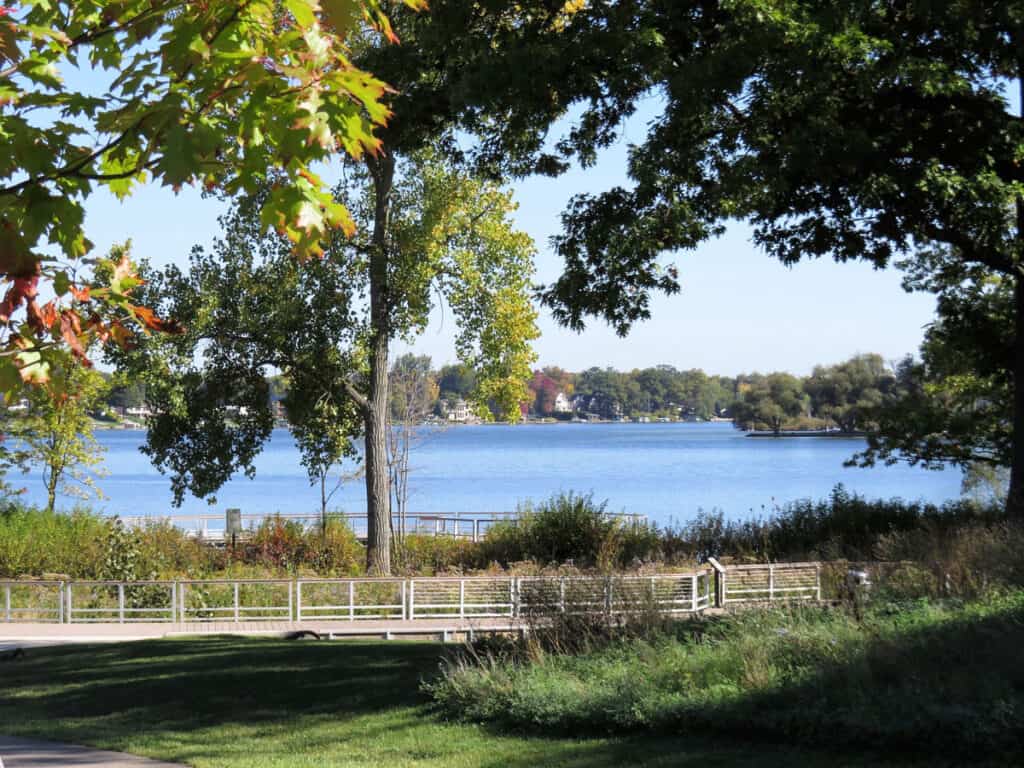
Cass Lake is the eighth largest lake in Minnesota and home to Star Island home to Lake Windigo forming a lake within an island within a lake!
©Ramondo R Gee/Shutterstock.com
● Surface Area: 15,958 acres
● Max Depth: 123 Feet
● Camping/Overnight Available: Yes
● Boating/Docks Available: Yes
● Swimming Permitted: Yes
● Fishing Permitted: Yes
● Best For: Eighth Largest Lake Entirely In Minnesota, Star Island & Lake Windigo, Historical Timer Industry Importance, Renowned Muskie Fishery, Jumbo Yellow Perch
Cass Lake is the eighth largest lake located entirely within the state of Minnesota. It is seated within the Chippewa National Forest and the Leech Lake Indian Reservation. Cass Lake is another one of Minnesota’s glacially formed bodies of water and was once called Upper Red Cedar Lake by early French explorers.
The Mississippi River runs through Cass Lake and serves as its primary inlet and outlet. Neighboring Pike Bay used to be tied together with Cass Lake however they’re two individual bodies of water today. Cass Lake is also home to Star Island a unique island with its own Lake Windigo, creating a lake within an island within a lake.
Fishing, boating, and swimming are all popular pastimes at Cass Lake. Muskie and jumbo yellow perch are the most notorious fish species at the lake. Other fish species anglers can expect to land at Cass Lake include northern pike, largemouth bass, rock bass, bluegill, and lake trout. Spring is the best time reported for walleye and crappie fishing at Lake Cass and muskie are regularly found near Star Island.
10. Lake of the Woods

Lake of the Woods is the sixth-largest freshwater lake in the USA and known as the Walleye Capital of the World.
©iStock.com/milendm
● Surface Area: 1.075M acres
● Max Depth: 210 Feet
● Camping/Overnight Available: Yes
● Boating/Docks Available: Yes
● Swimming Permitted: Yes
● Fishing Permitted: Yes
● Best For: Sixth Largest Freshwater Lake In USA, Walleye Capital of the World, Spectacular Muskie Fishing, Undeveloped Areas, Dense Wildlife Population, Zippel Bay State Park, Royal Lake of the Woods Yacht Club
Lake of the Woods is a massive glacially carved lake located in the north-central region of Minnesota. The huge lake stretches into parts of the Canadian provinces Ontario and Manitoba. Lake of the Woods is home to over fourteen thousand islands and has a sixty-five thousand mile shoreline.
The lake is known as The Walleye Capital of the World, with many other fish species swimming the waters. Other fish targeted by anglers at Lake of the Woods include northern pike, perch, sauger, crappie, panfish, smallmouth bass, largemouth bass, lake trout, lake sturgeon, and whitefish. Lake of the Woods also has a significant muskie population and is highly regarded for containing many of the species.
The lake’s remote location provides the perfect refuge and home to many types of birds and other wildlife. Piping plover and large numbers of American white pelicans use the area as nesting habitat and boreal woodland caribou utilize Lake of the Woods for calving. In addition, there are several hundred nesting pairs of bald eagles present in the area.
Summary of 10 Best Lakes for Fishing Minnesota
| Index | Lake | Fish Species |
| 1 | Red Lake | Walleye, northern pike, slab crappie, jumbo perch, black & brown bullhead, black crappie, bluegill, burbot, freshwater drum, golden redhorse, lake trout, lake whitefish, lake sturgeon, largemouth bass, muskie, quillback, rock bass, shorthead redhorse, white sucker, goldeye, and bigmouth buffalo |
| 2 | Rainy Lake | Walleye, smallmouth bass, crappie, northern pike, muskellunge, and sturgeon |
| 3 | Mille Lacs Lake | Walleye, northern pike, muskie, jumbo perch, smallmouth bass, largemouth bass, and tullibee. |
| 4 | Leech Lake | Largemouth bass, northern pike, sunfish, crappie, dogfish, bluegill, brown bullhead, catfish, eelpout, muskellunge, pumpkinseed, rock bass, smallmouth bass, tullibee, walleye, white sucker, yellow bullhead, yellow perch, and jackfish |
| 5 | Lake Winnibigoshish | Northern pike, perch, largemouth bass, black crappie, bluegill, hybrid sunfish, pumpkinseed sunfish, rock bass, and muskie. |
| 6 | Lake Vermilion | Walleye, muskellunge, northern pike, smallmouth bass, bluegills, crappies, and largemouth bass |
| 7 | Kabetogama Lake | Walleye, Northern pike, perch, smallmouth bass, crappie, bluegill, burbot, lake sturgeon, lake whitefish, largemouth bass, mooneye, northern pike, rock bass, sauger, shorthead redhorse, silver redhorse, tullibee, and white sucker |
| 8 | Lake Pepin | Northern pike, sauger, smallmouth bass, largemouth bass, |
| 9 | Cass Lake | Northern pike, largemouth bass, rock bass, bluegill, and lake trout |
| 10 | Lake of the Woods | Northern pike, perch, sauger, crappie, panfish, smallmouth bass, largemouth bass, lake trout, lake sturgeon, and whitefish |
The photo featured at the top of this post is © iStock.com/milendm
Thank you for reading! Have some feedback for us? Contact the AZ Animals editorial team.






